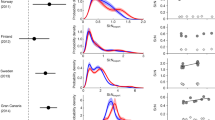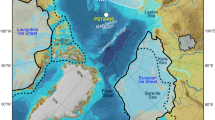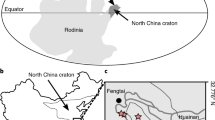Abstract
The modern Eastern Equatorial Pacific (EEP) Ocean is a large oceanic source of carbon to the atmosphere1. Primary productivity over large areas of the EEP is limited by silicic acid and iron availability, and because of this constraint the organic carbon export to the deep ocean is unable to compensate for the outgassing of carbon dioxide that occurs through upwelling of deep waters. It has been suggested that the delivery of dust-borne iron to the glacial ocean2,3 could have increased primary productivity and enhanced deep-sea carbon export in this region, lowering atmospheric carbon dioxide concentrations during glacial periods. Such a role for the EEP is supported by higher organic carbon burial rates documented in underlying glacial sediments4,5, but lower opal accumulation rates cast doubts on the importance of the EEP as an oceanic region for significant glacial carbon dioxide drawdown6,7. Here we present a new silicon isotope record that suggests the paradoxical decline in opal accumulation rate in the glacial EEP results from a decrease in the silicon to carbon uptake ratio of diatoms under conditions of increased iron availability from enhanced dust input. Consequently, our study supports the idea of an invigorated biological pump in this region during the last glacial period that could have contributed to glacial carbon dioxide drawdown. Additionally, using evidence from silicon and nitrogen isotope changes, we infer that, in contrast to the modern situation, the biological productivity in this region is not constrained by the availability of iron, silicon and nitrogen during the glacial period. We hypothesize that an invigorated biological carbon dioxide pump constrained perhaps only by phosphorus limitation was a more common occurrence in low-latitude areas of the glacial ocean.
This is a preview of subscription content, access via your institution
Access options
Subscribe to this journal
Receive 51 print issues and online access
$199.00 per year
only $3.90 per issue
Buy this article
- Purchase on Springer Link
- Instant access to full article PDF
Prices may be subject to local taxes which are calculated during checkout
 ) difference between the atmosphere and the ocean for 1995.
) difference between the atmosphere and the ocean for 1995.


Similar content being viewed by others
References
Takahashi, T. et al. Global sea-air CO2 flux based on climatological surface ocean pCO2, and seasonal biological and temperature effects. Deep-Sea Res. II 49, 1601–1622 (2002)
McGee, D., Marcantonio, F. & Lynch-Stieglitz, J. Deglacial changes in dust flux in the eastern equatorial Pacific. Earth Planet. Sci. Lett. 257, 215–230 (2007)
Winckler, G., Anderson, R. F., Fleisher, M. Q., McGee, D. & Mahowald, N. Covariant glacial-interglacial dust fluxes in the equatorial Pacific and Antarctica. Science 320, 93–96 (2008)
Pedersen, T. F. Increased productivity in the eastern equatorial Pacific during the Last Glacial Maximum (19,000 to 14,000 yr BP). Geology 11, 16–19 (1983)
Lyle, M. Climatically forced organic-carbon burial in equatorial Atlantic and Pacific oceans. Nature 335, 529–532 (1988)
Kienast, S. S., Kienast, M., Jaccard, S., Calvert, S. E. & Francois, R. Testing the silica leakage hypothesis with sedimentary opal records from the eastern equatorial Pacific over the last 150 kyrs. Geophys. Res. Lett. 33 10.1029/2006GL026651 (2006)
Bradtmiller, L. I., Anderson, R. F., Fleisher, M. Q. & Burckle, L. H. Diatom productivity in the equatorial Pacific Ocean from the last glacial period to the present: A test of the silicic acid leakage hypothesis. Paleoceanography 21 10.1029/2006PA001282 (2006)
Lisitzin, A. P. in The Micropalaeontology of Oceans Symposium, Illustrated Maps 173–195 (Cambridge University Press, 1971)
Moore, J. K., Doney, S. C. & Lindsay, K. Upper ocean ecosystem dynamics and iron cycling in a global three-dimensional model. Glob. Biogeochem. Cycles 18 10.1029/2004GB002220 (2004)
Dugdale, R. C. & Wilkerson, F. P. Silicate regulation of new production in the equatorial Pacific upwelling. Nature 391, 270–273 (1998)
Archer, D. & Maier-Reimer, E. Effect of deep-sea sedimentary calcite preservation on atmospheric CO2 concentration. Nature 367, 260–263 (1994)
Loubere, P. & Richaud, M. Some reconciliation of glacial-interglacial calcite flux reconstructions for the eastern equatorial Pacific. Geochem. Geophys. Geosyst. 8 10.1029/2006GC001367 (2007)
Richaud, M., Loubere, P., Pichat, S. & Francois, R. Changes in opal flux and the rain ratio during the last 50,000 years in the equatorial Pacific. Deep-Sea Res. II 54, 762–771 (2007)
Takeda, S. Influence of iron availability on nutrient consumption ratio of diatoms in oceanic waters. Nature 393, 774–777 (1998)
Hutchins, D. A. & Bruland, K. W. Iron-limited diatom growth and Si: N uptake ratios in a coastal upwelling regime. Nature 393, 561–564 (1998)
Reynolds, B. C., Frank, M. & Halliday, A. N. Silicon isotope fractionation during nutrient utilization in the North Pacific. Earth Planet. Sci. Lett. 244, 431–443 (2006)
Beucher, C. P., Brzezinski, M. A. & Jones, J. L. Sources and biological fractionation of silicon isotopes in the eastern equatorial Pacific. Geochim. Cosmochim. Acta 72, 3063–3073 (2008)
Brzezinski, M. A. et al. A switch from Si(OH)4 to NO3 depletion in the glacial Southern Ocean. Geophys. Res. Lett. 29 10.1029/2001GL014349 (2002)
Matsumoto, K., Sarmiento, J. L. & Brzezinski, M. A. Silicic acid leakage from the Southern Ocean: A possible explanation for glacial atmospheric pCO2 . Glob. Biogeochem. Cycles 16 10.1029/2001GB001442 (2002)
Beucher, C. P., Brzezinski, M. A. & Crosta, X. Silicic acid dynamics in the glacial sub-Antarctic: implications for the silicic acid leakage hypothesis. Glob. Biogeochem. Cycles 21 10.1029/2006GB002746 (2007)
Farrell, J. W., Pedersen, T. F., Calvert, S. E. & Nielsen, B. Glacial–interglacial changes in nutrient utilization in the equatorial Pacific Ocean. Nature 377, 514–517 (1995)
Toggweiler, J. R. & Carson, S. in Upwelling in the Ocean: Modern Processes and Ancient Records (eds Summerhayes, C. P., Emeis, K.-C., Angel, M. V., Smith, R. L. & Zeitzschel, B.) 337–360 (John Wiley & Sons, 1995)
Ganeshram, R. S., Pedersen, T. F., Calvert, S. E., McNeill, G. W. & Fontugne, M. R. Glacial-interglacial variability in denitrification in the world's oceans: causes and consequences. Paleoceanography 15, 361–376 (2000)
Altabet, M. A. Nitrogen isotopic evidence for micronutrient control of fractional NO3- utilization in the equatorial Pacific. Limnol. Oceanogr. 46, 368–380 (2001)
Pena, L. D., Cacho, I., Ferretti, P. & Hall, M. A. El Niño–Southern Oscillation–like variability during glacial terminations and interlatitudinal teleconnections. Paleoceanography 23 10.1029/2008PA001620 (2008)
Koutavas, A., Lynch-Stieglitz, J., Marchitto, T. M. & Sachs, J. P. El Nino-like pattern in ice age tropical Pacific sea surface temperature. Science 297, 226–230 (2002)
Ganeshram, R. S., Pedersen, T. F., Calvert, S. E. & Francois, R. Reduced nitrogen fixation in the glacial ocean inferred from changes in marine nitrogen and phosphorus inventories. Nature 415, 156–159 (2002)
Deutsch, C., Sigman, D. M., Thunell, R. C., Meckler, A. N. & Haug, G. H. Isotopic constraints on glacial/interglacial changes in the oceanic nitrogen budget. Glob. Biogeochem. Cycles 18 10.1029/2003GB002189 (2004)
Moore, J. K. & Doney, S. C. Iron availability limits the ocean nitrogen inventory stabilizing feedbacks between marine denitrification and nitrogen fixation. Glob. Biogeochem. Cycles 21 10.1029/2006GB002762 (2007)
Georg, R. B., Reynolds, B. C., Frank, M. & Halliday, A. N. New sample preparation techniques for the determination of Si isotopic compositions using MC-ICPMS. Chem. Geol. 235, 95–104 (2006)
Monnin, E. et al. Atmospheric CO2 concentrations over the last glacial termination. Science 291, 112–114 (2001)
Mortlock, R. A. & Froelich, P. N. A simple method for the rapid determination of biogenic opal in pelagic marine sediments. Deep-Sea Res. A 36, 1415–1426 (1989)
Francois, R., Frank, M., van der Loeff, M. M. R. & Bacon, M. P. Th-230 normalization: an essential tool for interpreting sedimentary fluxes during the late Quaternary. Paleoceanography 19 10.1029/2003PA000939 (2004)
Ellam, R. M. & Keefe, K. MC-ICP-MS analysis of non-natural U isotope ratios using a Th-229/Th-232 external mass bias correction. J. Anal. At. Spectrom. 22, 147–152 (2007)
Morley, D. W. et al. Cleaning of lake sediment samples for diatom oxygen isotope analysis. J. Paleolimnol. 31, 391–401 (2004)
Reynolds, B. C., Georg, R. B., Oberli, F., Wiechert, U. H. & Halliday, A. N. Re-assessment of silicon isotope reference materials using high-resolution multi-collector ICP-MS. J. Anal. At. Spectrom. 21, 266–269 (2006)
Acknowledgements
We thank R. Francois, S. Kienast, W. Geibert, E. Galbraith and G. Leduc for discussions. Funding for this project was provided by the Scottish Alliance for Geoscience Environment Society (SAGES), the Natural Environment Research Council (NERC) through a Standard NERC grant (to R.S.G. and L.E.P.) and a Marie Curie Intra-European fellowship (to L.E.P.). I.C. and L.P. acknowledge funding from the ROMIAT and GRACCIE-CONSOLIDER projects.
Author Contributions L.E.P. and R.S.G. initiated the project. L.E.P. and B.C.R. measured silicon isotopes in ETH Zurich, L.E.P. measured elemental composition and nitrogen isotopes, L.E.P., K.K. and R.M.E. made the 230Th measurements. I.C. and L.P. provided the age model. L.E.P. and R.S.G. wrote the paper with the participation of B.R.C. All authors participated in the discussions on the results and commented on the manuscript.
Author information
Authors and Affiliations
Corresponding author
Supplementary information
Supplementary Information
This file contains Supplementary Methods, Supplementary Data, Supplementary Figures 1-2 with Legends Supplementary Table 1 and Supplementary References. (PDF 377 kb)
PowerPoint slides
Rights and permissions
About this article
Cite this article
Pichevin, L., Reynolds, B., Ganeshram, R. et al. Enhanced carbon pump inferred from relaxation of nutrient limitation in the glacial ocean. Nature 459, 1114–1117 (2009). https://doi.org/10.1038/nature08101
Received:
Accepted:
Issue Date:
DOI: https://doi.org/10.1038/nature08101
This article is cited by
-
Insights into the deglacial variability of phytoplankton community structure in the eastern equatorial Pacific Ocean using [231Pa/230Th]xs and opal-carbonate fluxes
Scientific Reports (2022)
-
The nature of deep overturning and reconfigurations of the silicon cycle across the last deglaciation
Nature Communications (2020)
-
Reply to: No evidence for equatorial Pacific dust fertilization
Nature Geoscience (2019)
-
Smectite formation in metalliferous sediments near the East Pacific Rise at 13°N
Acta Oceanologica Sinica (2018)
-
No iron fertilization in the equatorial Pacific Ocean during the last ice age
Nature (2016)
Comments
By submitting a comment you agree to abide by our Terms and Community Guidelines. If you find something abusive or that does not comply with our terms or guidelines please flag it as inappropriate.



